Carl Olof Jansson
Third class passenger
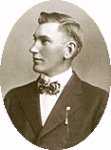
He “glanced toward the bridge and saw the chief officer place a revolver in his mouth and shoot himself. His body toppled overboard.."
In Triumph and Tragedy, he is listed as “Mr. Carl Olof Jansson” (p.342 (7.)) Some sources also list him as “Jansen,” "Janson" or “Johnson”. A 21 one-year-old from Orebo, Sweden, he embarked upon Titanic at Southampton, destined for Swedeburg, NE. He traveled in third class, or steerage.
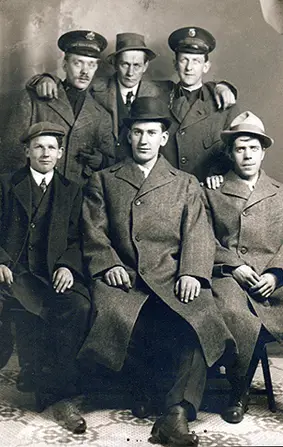
Carl Jansson is surrounded by three other
Titanic survivors and two Salvation Army
workers in this picture taken after the Carpathia
arrived in New York. Behind Johnson is
Wennerstrom, a fellow Swedish immigrant.
KARIN BREMAN (Click image to enlarge)
According to an article in The Omaha World Herald:
"Carl Jansson (he changed it to Johnson upon arriving in America) was a 21-year-old contractor's apprentice when he left Sweden to escape induction into the army. Carrying all he owned in a suitcase, he and some associates slipped over to Copenhagen, Denmark, and then traveled on a cattle boat to Southampton, England. There Johnson would find passage to America, planning to join his brother in the now-defunct town of Swedeburg, near Wahoo in Nebraska's Saunders County. Johnson's boarding pass, now in the hands of the Saunders County Historical Museum in Wahoo, shows he was originally supposed to sail aboard the Adriatic before he was transferred to the Titanic, likely due to a severe coal shortage that was docking many ships."(The Omaha World Herald, April 8, 2012)
Triumph and Tragedy lists collapsible A as the lifeboat he was in. Of course, this meant that Mr. Jansson was most probably on the starboard side, departing on the last boat to leave from that side, or was in the water at this time, finally seeking refuge in the collapsible. In other words, he was in the location and/or timeframe to view any alleged suicide. His being aboard collapsible A is confirmed by “August Andersson (Wennerström) [who] mentions Jansson by name as having been in Collapsible A with him” (Bill Wormstedt, Shots in the Dark (12.))
According to his other evidence he was on board Titanic when her stern lifted high into the air and her lights suddenly flickered off.
“We were suddenly plunged into darkness, save for the cold, clear light of the heavens, for it was a starlit night. I could not accustom myself to the change for several minutes. I think I was in a sort of daze and have no clear recollection of what happened afterward or how long a time had elapsed. Suddenly I heard shrieks and cries amidships, and the sharp reports of several shots. People began to run by me toward the stern of the ship, and as I started to run I realized that the boat was beginning to go down rapidly. There was another report, and then her nose was being buried. A wave struck me and I went overboard.” (The Titanic, Wyn Wade, p.212 (18.) and Titanic At 2AM, Paul Quinn, originally from the April 19, 1912 The New York Times (34.))
Jansson states the time that he went overboard as being when Titanic’s “nose was being buried” making the general time-frame similar to that when the wave hit the bridge and forward boat deck and collapsible A was washed overboard. However, the lights of Titanic did not flicker off until some moments after this, most historians placing it just before the ship breaks in two. However, from his evidence it is quite clear that he was in the vicinity and time-frame to witness what occurred, with many from steerage not appearing on the decks until it was too late.
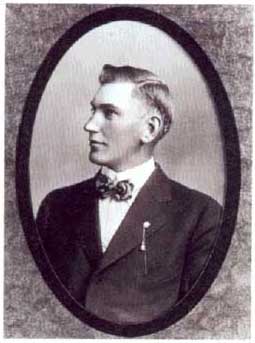
Carl Olof Jansson
He mentions “shrieks and cries amidships, and the sharp reports of several shots… there was another report, and then her nose was being buried.” Further details as to gunfire were clarified when he wrote in a private letter that he “glanced toward the bridge and saw the chief officer place a revolver in his mouth and shoot himself. His body toppled overboard.” (The Titanic, End of a Dream Wyn Craig Wade, p.53) (18.). As there was continued confusion over Wilde and Murdoch being Chief Officer, since both were called that title before and after the event, it leaves an element of doubt over the exact identity of the officer concerned. As a steerage passenger from Sweden, he would not be expected to know the exact title and name of the senior crew. Interestingly, the officer places the gun “in his mouth” rather than to his temple as some other accounts indicate
After arriving in New York Jansson was "fed, given new clothes and received $25 from the Salvation Army assistance committee." Later Jansson "Wennerstrom and Iowa survivor Tenglin all had their picture taken with a pair of Salvation Army workers. Then a week later, it was off to Nebraska. He first lived with his brother, Eric, in Swedeburg before moving to nearby Wahoo to begin his career as a building contractor." (The Omaha World Herald, April 8, 2012)
In a private email from Titanic researcher Peter Engberg-Klarström he mentions that Jansson's long letter, written in Swedish, dated 8 May, addressed from Swedeburg, Nebraska, to his brother says "the First Officer put a gun in his mouth and shot himself" -but he does not emphatically state that he saw this himself.
According to the Chicago American of Thursday 25 April 1912, under the headline of "Titanic victim in Chicago tells of Self-death":
"Carl Janson... is twenty-one and a robust young man. He was a third cabin passenger and after the wreck was nearly frozen to death. When he reached New York the White Star Line gave him a cheap suit of clothes, an overcoat and $10 in money to sign a release of the line from further damages. Janson lost $50 and all his luggage on the boat."
Janson saw Chief Officer Murdock shoot himself just before the last boat was launched. He gave a graphic story of the
sinking of the great liner with its human freight....Shortly before the last boat was launched I
glanced toward the bridge and saw the chief officer place a revolver in his mouth and shoot himself. His body topped
overboard. I waited for the last boat to leave and then jumped overboard myself. I was swimming not more than twenty feet
from the ship when she upended and went down.
The Titanic did not break in two, though there were two explosions. I saw her propellers as she went under. The suction
was small. A door from the wreck was flung near me and I grasped it with more than twenty others. We clung to that door
for hours. One by one the others slipped off and sank.
The water after the sinking of the Titanic was dotted with persons and floating ice cakes. The cries and moans continued
for hours. I cannot see why more could not have been rescued. It was 7 in the morning when I was picked up.”
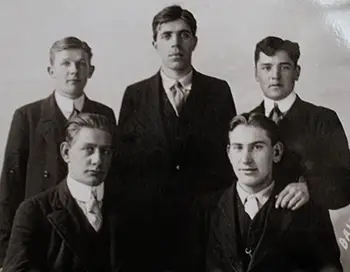
Carl Jansson lower right, with four other Titanic survivors
in 1912. KARIN BREMAN (Click image to enlarge)
Jansson also wrote a letter while aboard the Carpathia, but there is no specific mention of a sucide. He does however begin the letter with "I can't describe it all. One can't describe with a pencil the terrible things I witnessed." (The Omaha World Herald, April 5, 2012)
On Board the Cunard B.U.S. "Carpathia"
17 April, 1912
While I now write to you I can't enough Thank God that I am alive. I think when you receive this letter you'll think I am dead. Most likely the newspapers have written that the biggest ship in the world “Titanic'' has sunk with man and all.
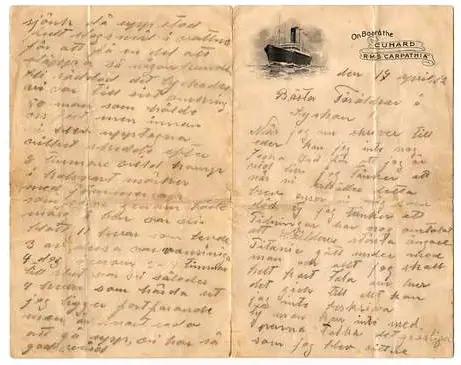
Dear Parents and brothers and sisters:
I will tell you shortly how it happened. I can't describe it all. One can't describe with a pencil the terrible things I witnessed.
Sunday night 11:30 we suddenly were informed that the boat had collided with an iceberg and was about to sink. We had only time to take on the trousers and the cap before the water came into the cabin, and we had to run up on deck. All the lifeboats were lowered and the rules and regulations were that women and children should be saved as far as possible. As the last boat was lowered, two Swedish girls wanted me to go on board with them, but I was blocked. A scream was heard: Women first! But when they saw me standing there without any hope of salvation, the girls threw themselves from the boat into the water.
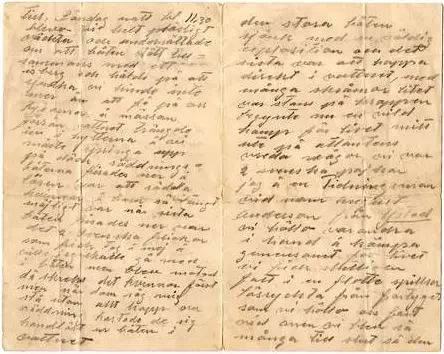
The big boat sank with a great explosion and the only thing to do was to jump into the water. With lots of scratches on the body I now began a struggle for life and death with the Atlantic's waves. We were two Swedish boys, I myself and a journalist who's name was August Suderssou (Wennerstrom) from Ystad. We fought side by side and finally we found a raft, torn loose from the ship which we clung firmly to, but finally we were too many so it sank. Then started a tough fight in the water, making some people release their hold, so others could be saved. It worked. Finally we were 50 men clinging to the raft, but before we were saved which happened after eight hours of wild struggle in the dark with plaintive cries that pierced the very marrow of my bones. There were only 11 alive, three of us now were insane, four persons died after three to four hours. Finally only four perservered. I am still in bed, but soon I am ready to go up. We get good care, so I think it will be a happy end. It has seemed very dark, but don't worry. In that case I don't wonder.
When I think of it, I can't understand how I could be saved, but my cold-bloodedness to push away the others from the raft so it could be kept on the sea level did much to it. It is awful, but in such a moment the only question is your own life. I cannot go on straining my mind anymore, and stop here with a hearty greeting to you from your through the providence of God saved son.
Carl O. Jansson
(The Omaha World Herald, April 5, 2012)
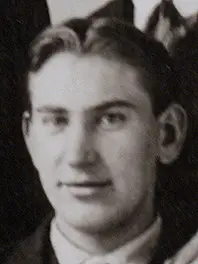
This letter once again confirms that he was in the water at the end, but also that he is a reliable witness with no evidence of fictional exaggeration.
Ironically, five years after sailing on Titanic to escape military service in Sweden he was "drafted into the U.S. Army in World War I and put back on a ship for Europe. Continuing his charmed existence, Johnson survived the front lines and returned to Wahoo." (The Omaha World Herald, April 8, 2012) He apparantly continued to give accounts of his experiences:
Over the years, he gave at least two accounts of the sinking to The World-Herald, including one in 1927 that was billed as his first ever. The accounts varied somewhat, and neither mentions the kind of man-against-man struggle on Collapsible A he described in his letter. In fact, the 1927 account said he survived by clutching a timber. Historians say it's not at all surprising Johnson would be reluctant to talk publicly of such a horrific experience, one that only someone who was there could fully comprehend." (The Omaha World Herald, April 8, 2012)
Jansson died in 1978 aged 87.
Verdict: